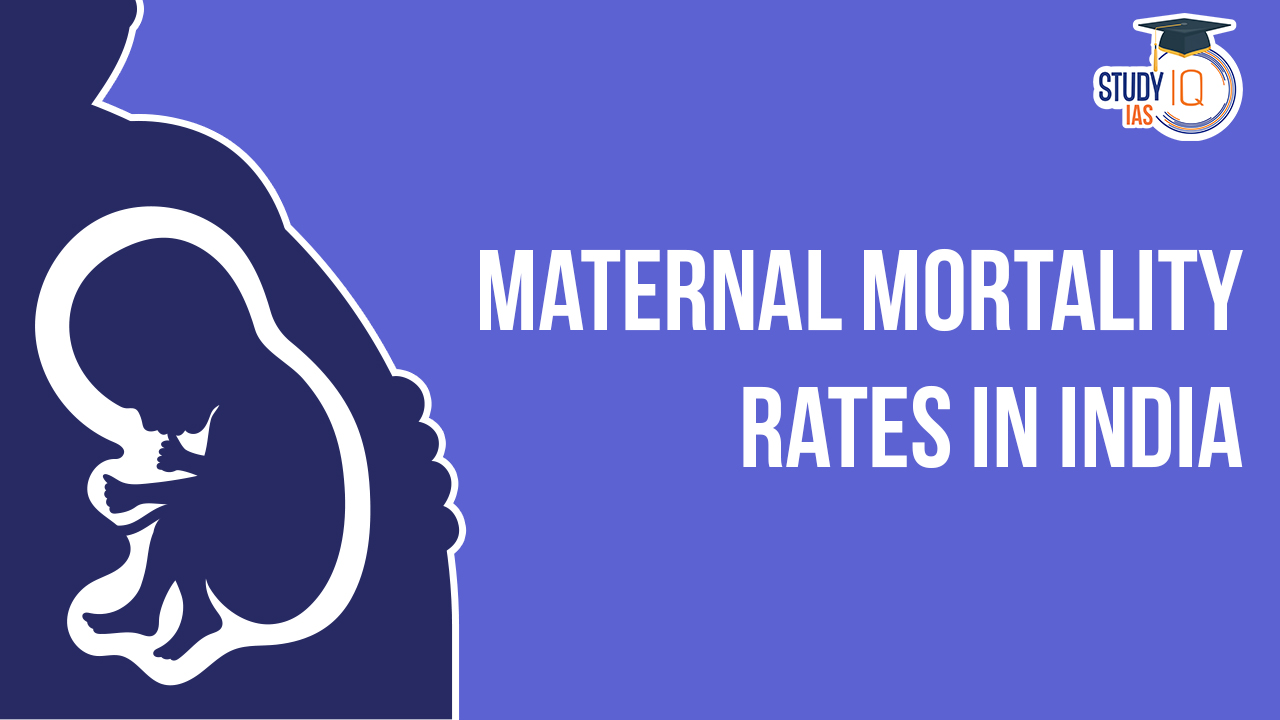Table of Contents
Context: Recently a group of various UN bodies released a report related to maternal mortality trends between 2000 to 2023.
Maternal Mortality Rate
The Maternal Mortality Rate (MMR) quantifies the number of maternal deaths per 100,000 live births resulting from pregnancy or pregnancy termination, irrespective of the stage or location of pregnancy. It serves as a crucial indicator of the risks associated with pregnancy for women.
Maternal Mortality Rates in India
Maternal mortality in India is the maternal death of a woman in India during pregnancy or after pregnancy, including post-abortion or post-birth periods. In India, the maternal mortality rate (MMR) has historically been notably high, yet recent trends indicate a decline. Accurately measuring maternal mortality is challenging, requiring comprehensive records of deaths and their causes, often obtained through surveys and census data.
Currently, Reproductive Age Mortality Studies (RAMOS) are considered the most effective method for calculating MMR. This approach involves analyzing various sources and records to gather data on reproductive-aged women’s deaths, supplemented by verbal autopsies to estimate mortality numbers. Globally and regionally, MMR is calculated every five years using regression models.
Key findings of the Report on Maternal Mortality Trends
- 40% global decline in maternal deaths between 2000 and 2023.
- In 2023, 2,60,000 maternal deaths occurred globally.
- This equals 1 maternal death every 2 minutes.
- Nigeria topped the list with 75,000 maternal deaths (28.7% of global total).
India’s Status
- In 2023, India reported 19,000 maternal deaths (52 per day).
- India accounted for 7.2% of global maternal deaths.
- MMR in India reduced from 362 in 2000 to 80 in 2023.
- Decline of 78% over the period.
- Maternal Mortality Ratio (MMR) = No. of maternal deaths per 1 lakh live births.
Maternal Mortality in India Insights
In India, the Sample Registration Survey (SRS) is utilized to estimate maternal mortality. The Office of the Registrar General’s Sample Registration System (SRS) issued a special bulletin on Maternal Mortality in India in March 2022, providing valuable insights into MMR trends.
| Time Period | Maternal Mortality Rate (MMR) per 100,000 live births |
|---|---|
| 2004-06 | 254 |
| 2007-09 | 212 |
| 2010-12 | 178 |
| 2011-13 | 167 |
| 2014-16 | 130 |
| 2015-17 | 122 |
| 2016-18 | 113 |
| 2018-20 | 97 |
Maternal Mortality in India State Wise
- Maternal mortality rates vary across states in India, with some states showing significantly higher rates compared to others.
- The Empowered Action Group (EAG) states and Assam exhibit higher MMRs compared to southern states and other states, highlighting regional disparities.
- Factors contributing to regional disparities include access to healthcare services, socioeconomic conditions, and educational levels.
| State | Maternal Mortality Rate (MMR) per 100,000 live births |
|---|---|
| Assam | High, with MMR of 480 in 2004-06 |
| Bihar | Varied, with MMR of 312 in 2004-06 |
| Jharkhand | MMR of 76 in 2004-06 |
| Madhya Pradesh | Varied, with MMR of 335 in 2004-06 |
| Chhattisgarh | Varied, with MMR of 141 in 2004-06 |
| Odisha | Varied, with MMR of 303 in 2004-06 |
| Rajasthan | Varied, with MMR of 388 in 2004-06 |
| Uttar Pradesh | Varied, with MMR of 440 in 2004-06 |
| Uttarakhand | Varied, with MMR of 89 in 2004-06 |
| Andhra Pradesh | Varied, with MMR of 154 in 2004-06 |
| Telangana | Varied, with MMR of 81 in 2004-06 |
| Karnataka | Varied, with MMR of 213 in 2004-06 |
| Kerala | Varied, with MMR of 95 in 2004-06 |
| Tamil Nadu | Varied, with MMR of 111 in 2004-06 |
| Gujarat | Varied, with MMR of 160 in 2004-06 |
| Haryana | Varied, with MMR of 186 in 2004-06 |
| Maharashtra | Varied, with MMR of 130 in 2004-06 |
| Punjab | Varied, with MMR of 192 in 2004-06 |
| West Bengal | Varied, with MMR of 141 in 2004-06 |
Special Bulletin on Maternal Mortality
- Maternal mortality ratio (MMR) in India has declined by 10 points, from 113 in 2016-18 to 103 in 2017-19, marking an 8.8% decrease.
- India is on track to achieve the National Health Policy (NHP) target of 100/lakh live births by 2020 and the Sustainable Development Goal (SDG) target of 70/lakh live births by 2030.
- Seven states have achieved the SDG target: Kerala, Maharashtra, Telangana, Tamil Nadu, Andhra Pradesh, Jharkhand, and Gujarat.
- Nine states have achieved the MMR target set by the National Health Policy, including Karnataka and Haryana.
- Despite national improvement, Bihar, Odisha, Rajasthan, Chhattisgarh, Madhya Pradesh, Uttar Pradesh, and Assam still have very high MMRs (130 or more maternal deaths per 100,000 live births).
- Uttarakhand, West Bengal, and Punjab have high MMRs (100-130 maternal deaths per 100,000 live births).
- Karnataka and Haryana have low MMRs (71-100 maternal deaths per 100,000 live births).
- Uttar Pradesh, Rajasthan, and Bihar have seen significant drops in MMR, despite still having high levels of maternal mortality.
- Kerala has the lowest MMR, while Assam has the highest.
- West Bengal, Haryana, Uttarakhand, and Chhattisgarh have recorded an increase in MMR compared to the previous survey, contrary to the national trend.
| Definition | States | |
| Very high maternal mortality | 130 or more maternal deaths per 100,000 live births. | Bihar (130), Odisha (136), Rajasthan (141), Chhattisgarh (160), Madhya Pradesh (163), Uttar Pradesh (167) and Assam (205). |
| High maternal mortality: | 100-130 maternal deaths per 100,000 live births. | Uttarakhand (101), West Bengal (109) and Punjab (114). |
| Low maternal mortality: | 71-100 maternal deaths per 100,000 live births. | Karnataka (83) and Haryana (96). |
Causes of Maternal Mortality in India
Maternal mortality in India can be attributed to various causes, including:
- Severe Bleeding (Hemorrhage): Excessive bleeding during childbirth, often due to complications like placenta previa or uterine rupture, can lead to maternal death if not promptly managed.
- Infections: Infections acquired during pregnancy, childbirth, or the postpartum period, such as sepsis or puerperal fever, can escalate rapidly and result in maternal mortality if not treated promptly with appropriate antibiotics.
- High Blood Pressure Disorders: Conditions like pre-eclampsia and eclampsia, characterized by high blood pressure during pregnancy, can lead to life-threatening complications for both the mother and the fetus if left untreated.
- Delivery-related Complications: Issues arising during delivery, such as obstructed labor, prolonged labor, or complications with anesthesia, can increase the risk of maternal mortality.
- Unsafe Abortions: Maternal deaths can occur due to complications arising from unsafe abortion practices, including hemorrhage, infection, and organ damage.
- Other Obstetric Causes: Maternal mortality may also result from complications such as ruptured uterus, hepatitis, anemia, or other obstetric emergencies.
- Underlying Health Conditions: Pre-existing health conditions like diabetes, heart disease, or HIV/AIDS can exacerbate during pregnancy and increase the risk of maternal mortality if not adequately managed.
- Social and Economic Factors: Factors such as poverty, limited access to healthcare, lack of education, and cultural practices may contribute to delays in seeking and receiving appropriate maternal healthcare, thus increasing the risk of maternal death.
Prevention and Interventions
- Maternal mortality is largely preventable, necessitating effective healthcare interventions and strategies.
- Key prevention strategies include prioritizing maternal and child health services, improving access to quality healthcare during pregnancy and childbirth, and promoting community-based delivery huts.
- Government initiatives like the Pradhan Mantri Surakshit Matritva Abhiyan aim to provide free and comprehensive maternal care services to pregnant women.
Social Factors and Impacts
- Social determinants like income inequality, access to prenatal and postpartum care, women’s education, sanitation levels, and caste dynamics significantly influence maternal mortality rates.
- Addressing social factors alongside healthcare interventions is crucial for reducing maternal mortality and improving overall maternal health outcomes.
Maternal Mortality Rate in India Government Initiatives
| Program Name | Description |
|---|---|
| Surakshit Matritva Aashwasan (SUMAN) | Provides free, dignified, and respectful healthcare for women and newborns at public health facilities. |
| Janani Shishu Suraksha Karyakaram (JSSK) | Provides free delivery, including caesarean sections, at public health facilities, as well as free transport, diagnostics, medicines, and blood. |
| Comprehensive Abortion Care Services | Provides medications, equipment, information, education, and communication (IEC), and training for healthcare professionals regarding abortion care. |
| Midwifery Program | Develops Nurse Practitioners in Midwifery who can provide compassionate care for women, mothers, and newborns. |
| Pradhan Mantri Surakshit Matritva Abhiyan (PMSMA) | Utilizes green and red stickers to identify women with no risk factors and those with high-risk pregnancies. |
Maternal Mortality Rates in India UPSC
- Despite significant progress, maternal mortality remains a challenge in India, particularly in certain regions and among marginalized communities.
- Continued efforts focusing on healthcare infrastructure, access to quality services, education, and addressing social determinants are essential for achieving sustainable reductions in maternal mortality and ensuring safe motherhood for all women in India.


 Geo-tagging of Buildings During Upcoming...
Geo-tagging of Buildings During Upcoming...
 Gender Gap in Educational Expenditure in...
Gender Gap in Educational Expenditure in...
 Reservation and 50% Cap: Constitutional ...
Reservation and 50% Cap: Constitutional ...

























